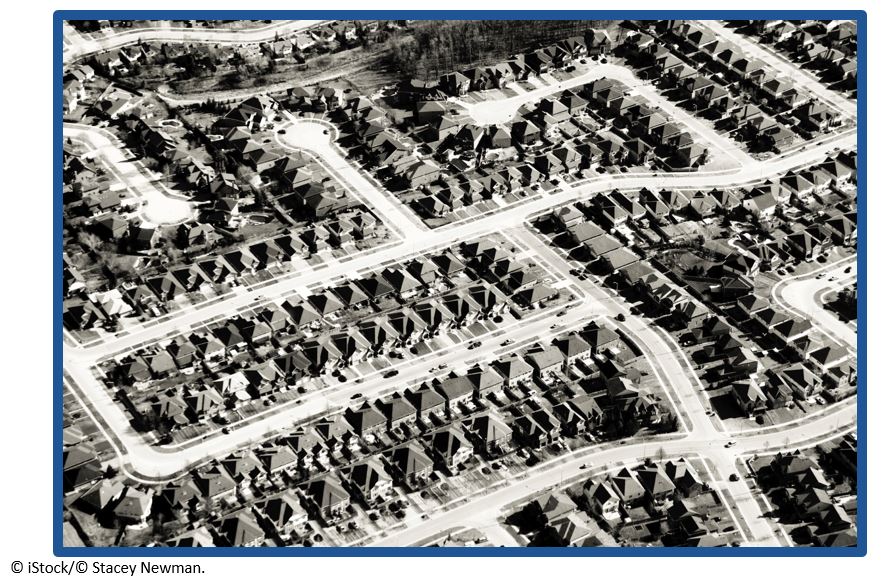8th Grade Suburbs Inquiry
Were Suburbs Good for America?
Entire Inquiry Can Be Downloaded Here
Were Suburbs Good for America?
Entire Inquiry Can Be Downloaded Here
Supporting Question 1- What were the economic and social conditions in the United States after World War II?
- Source A: Chart showing United States birth numbers, “Live Births in the United States, 1930–2008,” 2015
- Source B: Chart showing GDP and unemployment for the 30-year period spanning the Great Depression, World War II, and the postwar period, “Gross Domestic Product and Unemployment, 1933–1960,” 2015
- Source C: Chart showing the change in rates for 30-year mortgages in the 20th century, “30-Year Mortgage Rates,” 1961 NOTE: Mortgages rates are annual fees that lenders charge on the repayment of a loan. The concepts of compound interest and amortization affect how mortgage rates work. For example, if a lender charges 10 percent interest on a 10 year loan of $100,000, then the person who borrowed the money would need to pay compounded interest in addition to the $100,000 they borrowed. On a traditional amortized mortgage loan, over the 10 year life of the loan, the borrower would end up paying $58,580.88 in interest in addition to the principal of $100,000. The Federal Housing Administration (FHA), which sets standards for housing construction and insures housing loans, was created in 1934. The Federal National Mortgage Association, or Fannie Mae, which helps expand home ownership by providing local banks with money to finance home mortgages, was created in 1938.?
Supporting Question 2- How and why did suburbs grow in the 1950s?
- Source A: Army Times, information provided to soldiers returning from World War II about benefits available to them, The GI Bill of Rights and How it Works (excerpt), no date
- Source B: Dwight D. Eisenhower, message to Congress, “Special Message to the Congress Regarding a National Highway Program” (excerpt), February 22, 1955; Secretary of Commerce, map of United States interstate road system showing the estimated need for roadways by 1965, from Needs of the Highway Systems 1955–84, March 28, 1955 Public domain.
- Source C: Crystal Galyean, article about the development of one of the first suburban communities, “Levittown: The Imperfect Rise of American Suburbs” (excerpts), April 10, 2015. Reprinted with permission from US History Scene: http://ushistoryscene.com/article/levittown/Source D: Chart depicting home ownership rates from 1890 to 2010, “Home Ownership Rates over Time,” 2015
Supporting Question 3- What were the potential benefits of suburbanization?
- Source A: Long Island Library Resources, collection of historical images from the Levittown Public Library, Long Island Memories NOTE: The suburban ideal can be examined through multiple lenses, including primary source texts, detailed charts and metrics, and imagery. The Long island Memories collection contains a trove of photographs that serve to tell the visual story of the growth of Levittown, New York.
This collection is from the Long Island Library Resources (LILRC) Regional Digitization Program.
To support their research, students should be directed to browse this collection with an eye toward key questions such as:
- Other than the homes, what other features did the developers use to draw people to Levittown?
- What was the relationship between assembly-line techniques and price?
- What was the rationale for designing curved streets?
- Why were these homes attractive to veterans?
- Source B: State Museum of Pennsylvania, collection of historical images from the exhibit Building the Suburban Dream NOTE: Suburbs provided the housing to support the booming postwar birth rates trend, but these planned communities also promoted organized social engagement and fostered the growth of America’s consumer culture. Although critics argue that the suburbs homogenized the American experience, supporters identify benefits related to strengthened social institutions (e.g., American Legion, Little League baseball, women’s clubs) and an economy that grew as a result of social mobility and a pioneering spirit.
These photographs are from the State Museum of Pennsylvania exhibit Building the Suburb Dream, about the Levittown, Pennsylvania, development. They are available at http://statemuseumpa.org/levittown/.
To support their research, students should be directed to browse this collection and related readings with an eye toward key questions such as:
- What social institutions promoted a strong connection to Levittown, Pennsylvania?
- What role did the television play in suburban life?
- Which consumer products promoted a sense of affluence?
- How did the Levittown kitchen represent progress?
Supporting Question 4- What were some of the problems that suburbanization created?
- Source A: Malvina Reynolds, song about tract housing, “Little Boxes,” 1962 NOTE: Malvina Reynolds and her husband were on their way from their home in Berkeley, California, through San Francisco and down the peninsula to La Honda, where she was to sing at a meeting of the Friends’ Committee on Legislation. As she drove through Daly City, she said “Bud, take the wheel. I feel a song coming on.” A video of “Little Boxes” sung by Pete Seeger is available at YouTube: https://www.youtube.com/watch?v=HlSpc87Jfr0&list=RDHlSpc87Jfr0#t=95.
- Source B: John Kenneth Galbraith, book about the effects of suburbanization, The Affluent Society (excerpts), 1958 Reprinted with permission from J. K. Galbraith. The Affluent Society. Boston: Houghton Mifflin Company, 1958.
- Source C: Michael Harrington, book about the effects of suburbanization on social classes, The Other America (excerpts), 1962 Reprinted with permission from Michael Harrington. The Other America. New York: Penguin, 1962